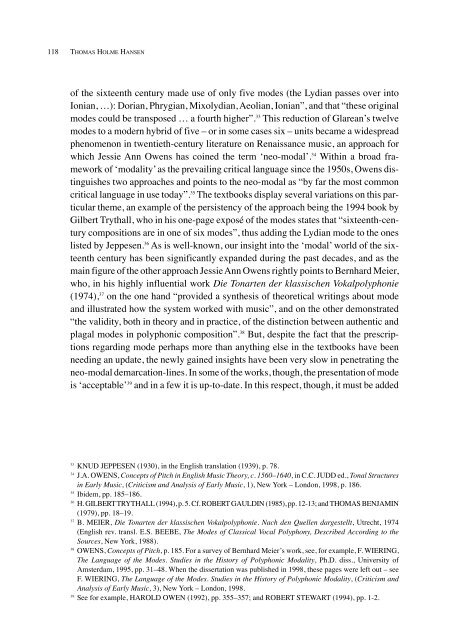YEARBOOK OF THE ALAMIRE FOUNDATION
YEARBOOK OF THE ALAMIRE FOUNDATION
YEARBOOK OF THE ALAMIRE FOUNDATION
Create successful ePaper yourself
Turn your PDF publications into a flip-book with our unique Google optimized e-Paper software.
118 THOMAS HOLME HANSEN<br />
of the sixteenth century made use of only five modes (the Lydian passes over into<br />
Ionian, …): Dorian, Phrygian, Mixolydian, Aeolian, Ionian”, and that “these original<br />
modes could be transposed … a fourth higher”. 33 This reduction of Glarean’s twelve<br />
modes to a modern hybrid of five – or in some cases six – units became a widespread<br />
phenomenon in twentieth-century literature on Renaissance music, an approach for<br />
which Jessie Ann Owens has coined the term ‘neo-modal’. 34 Within a broad framework<br />
of ‘modality’as the prevailing critical language since the 1950s, Owens distinguishes<br />
two approaches and points to the neo-modal as “by far the most common<br />
critical language in use today”. 35 The textbooks display several variations on this particular<br />
theme, an example of the persistency of the approach being the 1994 book by<br />
Gilbert Trythall, who in his one-page exposé of the modes states that “sixteenth-century<br />
compositions are in one of six modes”, thus adding the Lydian mode to the ones<br />
listed by Jeppesen. 36 As is well-known, our insight into the ‘modal’ world of the sixteenth<br />
century has been significantly expanded during the past decades, and as the<br />
main figure of the other approach Jessie Ann Owens rightly points to Bernhard Meier,<br />
who, in his highly influential work Die Tonarten der klassischen Vokalpolyphonie<br />
(1974), 37 on the one hand “provided a synthesis of theoretical writings about mode<br />
and illustrated how the system worked with music”, and on the other demonstrated<br />
“the validity, both in theory and in practice, of the distinction between authentic and<br />
plagal modes in polyphonic composition”. 38 But, despite the fact that the prescriptions<br />
regarding mode perhaps more than anything else in the textbooks have been<br />
needing an update, the newly gained insights have been very slow in penetrating the<br />
neo-modal demarcation-lines. In some of the works, though, the presentation of mode<br />
is ‘acceptable’ 39 and in a few it is up-to-date. In this respect, though, it must be added<br />
33 KNUD JEPPESEN (1930), in the English translation (1939), p. 78.<br />
34 J.A. OWENS, Concepts of Pitch in English Music Theory, c. 1560–1640, in C.C. JUDD ed., Tonal Structures<br />
in Early Music, (Criticism and Analysis of Early Music, 1), New York – London, 1998, p. 186.<br />
35 Ibidem, pp. 185–186.<br />
36 H. GILBERTTRYTHALL (1994), p. 5. Cf. ROBERT GAULDIN (1985), pp. 12-13; and THOMAS BENJAMIN<br />
(1979), pp. 18–19.<br />
37 B. MEIER, Die Tonarten der klassischen Vokalpolyphonie. Nach den Quellen dargestellt, Utrecht, 1974<br />
(English rev. transl. E.S. BEEBE, The Modes of Classical Vocal Polyphony, Described According to the<br />
Sources, New York, 1988).<br />
38 OWENS, Concepts of Pitch, p. 185. For a survey of Bernhard Meier’s work, see, for example, F. WIERING,<br />
The Language of the Modes. Studies in the History of Polyphonic Modality, Ph.D. diss., University of<br />
Amsterdam, 1995, pp. 31–48. When the dissertation was published in 1998, these pages were left out – see<br />
F. WIERING, The Language of the Modes. Studies in the History of Polyphonic Modality, (Criticism and<br />
Analysis of Early Music, 3), New York – London, 1998.<br />
39 See for example, HAROLD OWEN (1992), pp. 355–357; and ROBERT STEWART (1994), pp. 1-2.











